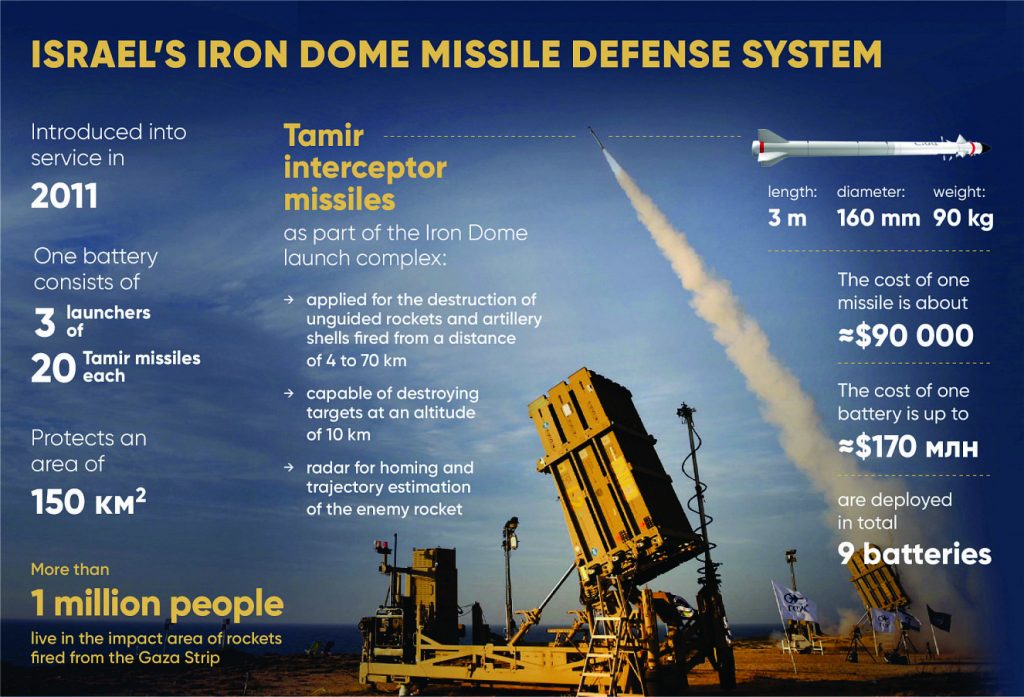ISRAEL’S IRON DOME
Israel’s Iron Dome anti-missile system has been the object of lavish praise in Western media outlets over the past few days, as the Israeli military bombards Gaza and uses the system to shoot down rockets fired by Palestinian groups into Israeli territory. However, according to open sources, Israel underwent the longest-reaching rocket assault in its history at the time, as the Palestinian factions fired more than 10,000 rockets from within Gaza, some with ranges covering most of Israel’s territory. Hamas’s flexing its rocket muscles was an important test for Israel’s Iron Dome that was developed by the country’s Rafael Advanced Defense Systems and Israel Aerospace Industries, with financing from the US, and was put into service in 2011.
What is Iron Dome?
Iron Dome is a multi-mission system capable of intercepting rockets, artillery, mortars and Precision Guided Munitions like very short range air defence (V-SHORAD) systems as well as aircraft, helicopters and Unmanned Aerial Vehicles (UAV) over short ranges of up to 70 km. It is an all-weather system and can engage multiple targets simultaneously and be deployed over land and sea.
Iron Dome is manufactured by Rafael Advanced Defence Systems Limited and has been in service with Israeli Air Force since 2011. The radar system was developed by Elta. Its development was prompted after a series of rocket attacks on Israel by Hezbollah and Hamas in the 2000s. In the 2006 Lebanon war, around 4,000 rockets were fired on the northern parts of Israel resulting in the death of about 44 Israeli civilians and evacuation of around 250,000 citizens.
How does it work?
The Iron Dome works by using anti-missile missiles and radar technology. An Iron Dome battery consists of a battle management control unit, a detection and tracking radar and a firing unit of three vertical launchers, with 20 interceptor missiles each. The interceptor missile uses a proximity fuse to detonate the target warhead in the air. The Iron Dome is deployed in a layered defence along with David’s Sling and Arrow missile defence system which are designed for medium- and long-range threats.
According to a 2013 research paper by Yiftah S. Shapur titled ‘Lessons from the Iron Dome’ in Military and Strategic Affairs, one of the system’s important advantages is its ability to identify the anticipated point of impact of the threatening rocket, to calculate whether it will fall in a built-up area or not, and to decide on this basis whether or not to engage it. This prevents unnecessary interception of rockets that will fall in open areas and thus not cause damage, the paper states.
The system has intercepted thousands of rockets so far and, according to Rafael, its success rate is over 90%. The I-DOME is the mobile variant with all components on a single truck and C-DOME is the naval version for deployment on ships.
Limitations of the system
Iron Dome, like any other defence system, is not leak-proof. The system can see limitations when it is overwhelmed with a barrage of projectiles. The system has a ‘saturation point’. It is capable of engaging a certain number of targets at the same time, and no more. Additional rockets fired in a crowded salvo could succeed in breaching defences and cause damage. Several assessments suggest that Hamas is developing mitigating strategies including lowering the trajectories of the projectiles while also continuing to accumulate thousands of rockets with improved precision.
According to a November 2017 commentary on RAND Corporation blog by Elizabeth M. Bartels, the system is built to intercept a certain number of projectiles and can be overwhelmed by a more capable adversary. According to Ms. Bartels, the planning scenario for a war with “Hezbollah involves 1,000-1,500 rockets per day fired at Israeli population centres.”
 Jahangir's World Times First Comprehensive Magazine for students/teachers of competitive exams and general readers as well.
Jahangir's World Times First Comprehensive Magazine for students/teachers of competitive exams and general readers as well.




